Matrox AltiZ high-fidelity 3D profile sensor powers TUNASCAN vision system, sorting up to 20 tons of tuna per hour with accuracy rates approaching 100%
 3D Vision System Nets the Right Tuna
3D Vision System Nets the Right Tuna

3D Vision System Nets the Right Tuna
Case Study from | Matrox Imaging
Headquartered in Spain, Marexi Marine Technology Co. has been a leader in marine technology for more than 15 years. Their expertise is developing optical scanning systems for marine species built on machine vision. Servicing large industry leaders in fishing, canning, and aquaculture sectors, Marexi helps customers achieve a competitive advantage by improving their industrial processes. Their patented TUNASCAN® system is Marexi’s most state-of-the-art machine, a high-speed and high-throughput vision system that scans and classifies tuna by species, size, and quality.
Proper visual classification of fish is quite a challenging undertaking, especially once the various species have been frozen. Differences between species become practically impossible to perform reliably without exhaustive testing. An automatic frozen tuna classification system, TUNASCAN was developed and refined over the course of five years. Using cutting-edge 3D profile sensors along with machine-learning algorithms, TUNASCAN is able to properly classify and sort tuna by species with accuracy rates of more than 95%.
“Machine vision technology is constantly evolving, and we are always seeking ways to further enhance our solutions in order to keep improving and providing the best service possible,” notes Pau Sánchez Carratalá, vision and robotics engineer at Marexi. “In the interest of improving the classification algorithms used by TUNASCAN, we undertook an overhaul of the entire acquisition system with the support of Matrox® Imaging and Grupo Alava, to offer more robustness, help avoid voids, and make the system easier to calibrate.”
Just keep scanning
The TUNASCAN system is a major fixture of Marexi’s marine technology offerings; this patented two-channel vision system can process up to 20 tons of frozen tuna per hour, classifying the fish by species and weight. The 3D scanning and classification system is divided into three sections: reception hopper, scanning, and sorting. From the reception hopper, frozen tuna are fed into the system and pass through the scanning section, where two Matrox AltiZ sensors perform a 3D scan and a computer classifies each tuna individually, with classification results and location data sent to the sorting system. Once there, each tuna is properly sorted into its appropriate container. “Marexi works with many machine vision products,” says Sánchez Carratalá, “so whenever we are making decisions about what elements to implement in a project, Matrox Imaging software, components, and systems have always been a preferred option of ours.
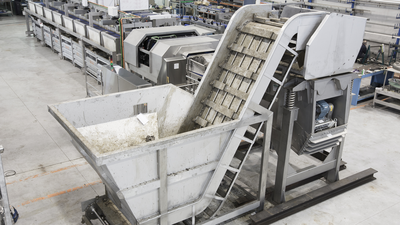
Tuna gets fed into the reception hopper directly from a truck. The reception hopper feeds tuna one by one into the TUNASCAN system, assuring proper spacing on the line.
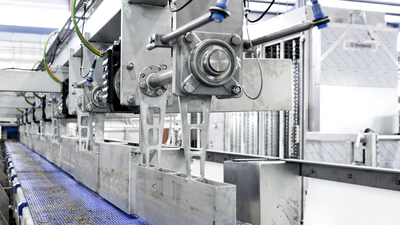
Tuna are then scanned by two Matrox AltiZ before being classified and sorted into containers. The 3D classification results and location data is sent to the sorting section.
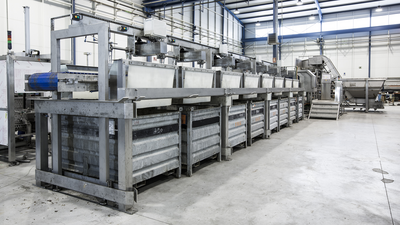
In the sorting section, each tuna is automatically sorted into its appropriate container. When full, each container is removed and replaced using a forklift. The TUNASCAN system holds more containers than classes so a container can be removed while the machine continues to operate at full capacity.
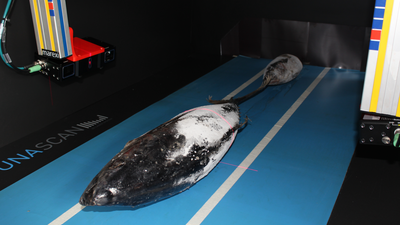
Two Matrox AltiZ 3D profile sensors (on the far left and right) scan each fish as it passes through the dual-sensor TUNASCAN system.
Clear fishy fishy
Upgrades to the TUNASCAN project centered upon Matrox AltiZ 3D profile sensors. Sánchez Carratalá notes, “we chose Matrox AltiZ sensors because our application required a strong, reliable way to obtain 3D point clouds from objects moving at a fairly fast speed; the application also must be able to deal with a lot of point-cloud noise and dirtiness produced by the tuna as well as physical operation of the machine. As such, an enclosed 3D profiler suited for harsh industrial environments—like the Matrox AltiZ—was a really good choice. In the past we used separate cameras and lasers for obtaining 3D data, however, Matrox AltiZ allows us to integrate all these elements into a single sensor that provides exceptional robustness to the application.” The dual-camera single-laser design of the Matrox AltiZ achieves what could not be accomplished with common 3D profile sensors that feature one laser and a single camera, and is thus able to attain the high reproduction fidelity that Marexi sought for their system. “In the past we’ve tested and worked with several other vision suppliers,” Sánchez Carratalá continues, “but we found that the combined software and hardware from Matrox Imaging are ideal solutions for our applications. We’ve always been satisfied with the results, so we always try Matrox Imaging before other solutions because we know it’s reliable and will help us achieve our goals.”
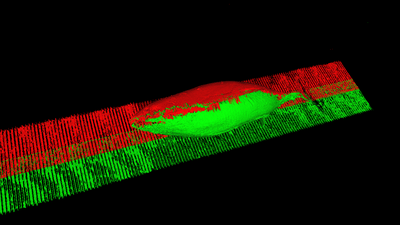
An onscreen rendition of the 3D point cloud generated by the two Matrox AltiZ.
TUNASCAN employs machine learning to accurately classify frozen tuna based on the features extracted from the point-cloud representation and calculated weight. Matrox Capture Works—the interactive set-up utility for the Matrox AltiZ—was used to configure the 3D sensor and provide the code snippet for the acquisition portion of the actual application.
For the purpose of the TUNASCAN system, the Matrox AltiZ devices are set to generate a point cloud. The laser lines trace the contours of the fish, and the embedded algorithms in the 3D sensors then produce a point cloud; each point represents a single measurement. The point cloud is stitched together to create a complete 3D rendering of the tuna. The algorithm ensures greater control over invalid data, resulting in more robust 3D reproductions. A challenge for this system was acquiring data at a relatively high rate as the frozen tuna moved across the line quickly, something that the use of two Matrox AltiZ 3D profile sensors accomplished with ease.
The TUNASCAN system also includes several ultrasonic sensors that trigger the Matrox AltiZ to begin 3D capture only when there is a fish available to scan. Special low-temperature infrared sensors are responsible for monitoring the temperature of each fish and assuring the proper behavior of the system.
Fishing for results
Operator interaction with the TUNASCAN system is minimal. An easy-to-use interface lets the operator choose output categories by species and weight, so that, in addition to sorting by species, the same species of tuna can be sorted into different groups according to their weight. TUNASCAN automatically sorts every incoming fish into the selected categories by container. When a container is full, the system informs the operator so that the full container can be removed from the line and a new one added to the operation. TUNASCAN manages multiple containers, automatically assigning a new container for output while the full container is being replaced, ensuring the system remains in continuous operation.
TUNASCAN systems are deployed in harsh environments and regularly exposed to cold, salt, dirt, fish scales, and humidity. The systems operate continuously, leaving very little opportunity for maintenance or calibration. “One of our installations has been working up to 20 hours a day, six days a week for almost three years, with barely any maintenance required,” Sánchez Carratalá smiles. “All that, and with accuracy rates approaching 100%! Our clients could not be more pleased with the system.”
In the swim of things
Development of the TUNASCAN system involved about 20 individuals, including computer engineers, physicists, and mathematicians, among others, all with extensive experience in machine vision systems. The TUNASCAN project has been underway for nearly five years; as part of Marexi’s commitment to continuous improvement of their products, it has been regularly improved and optimized over that time. “We faced some challenges at the start of the project, mainly because it is a very complex and disruptive system, and we needed to guarantee its robustness and efficacy. We are really happy with the assistance offered by Matrox Imaging’s technical support team, as well as the help received from Grupo Alava,” Sánchez Carratalá reports, “and we know we can always count on getting help from both of those teams. We’ve solved our development problems thanks to them, and now the equipment is a reality and available to customers.”
Building on the success of the TUNASCAN upgrade, Marexi is currently working on a different project for the fish industry that also integrates a Matrox AltiZ, along with Matrox Imaging Library (MIL) X software. Marexi has four other projects in development that incorporate MIL X, and they anticipate starting three more in 2021. A notable example of a project already being commercialized is called UVPress, which uses the deep-learning capabilities in MIL X to properly identify, count, and evaluate anisakis infections in fish samples. Thus far in 2021, Marexi has received inquiries from many international clients about the TUNASCAN system; Sánchez Carratalá notes that “commercial negotiation periods for this type of product can take upwards of a year, as they are often dependent on government permits, and other factors outside the client company itself. We hope that 2022 will be the year of commercialization in which we can build multiple units.”
Conclusion
Marexi reports that their current clients with TUNASCAN installations are very satisfied with the system and value it provides their businesses. “Matrox Imaging is an industry-leading company with its own development and manufacturing capacity that allows its solutions to always be at the forefront of innovation. Their robust products are perfect for the industrial demands of our clients. In short, Matrox Imaging is a reliable partner and supplier that meets the quality and service criteria Marexi wants to transmit to our customers,” says Sánchez Carratalá.
“Our TUNASCAN application really leverages the strengths of a Matrox AltiZ-based system,” Sánchez Carratalá concludes. “Not only do the sensors deliver very accurate 3D data at really high conveyor speeds while dealing with a challenging product like frozen tuna, but the Matrox AltiZ functions optimally in extremely harsh environments and works for really long periods of time without maintenance.”
The content & opinions in this article are the author’s and do not necessarily represent the views of RoboticsTomorrow
Comments (0)
This post does not have any comments. Be the first to leave a comment below.
Featured Product

IP Seals for Robots
Freudenberg Sealing Technologies' IPRS (Ingress Protection Seals for Robots) provides reliable protection for robotic systems operating in harsh environments. Designed to prevent dust, moisture, chemicals, and wear from compromising performance, IPRS extends service life and reduces maintenance. The adaptive Z-shaped geometry ensures sealing integrity under continuous motion, making it ideal for high-speed automation and outdoor applications. Manufactured with high-performance elastomers such as Fluoroprene XP and EPDM, IPRS offers exceptional resistance to lubricants, cleaning agents, and extreme temperatures. This makes it the perfect solution for six-axis robots, SCARA robots, AMRs, AGVs, and cobots.
With its low-friction design and durable materials, IPRS enhances energy efficiency and operational reliability in industrial and autonomous robotics. Learn more about our IPRS Seals
